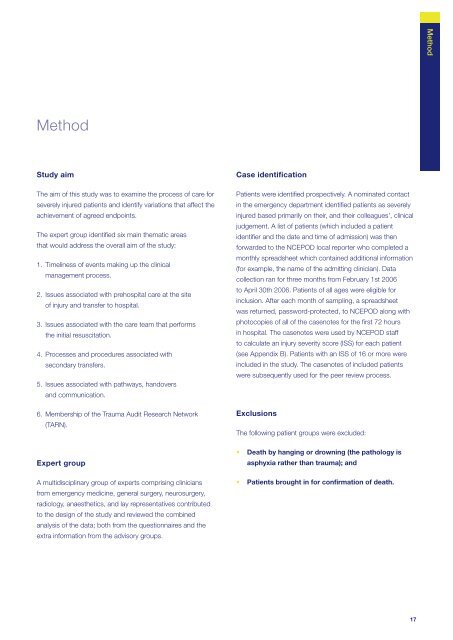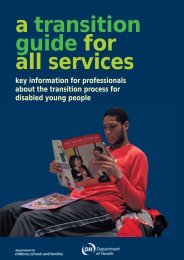IntroductionReferences1. Chaira 0, Cimbanissi S. Organized trauma care: doesvolume matter and do trauma centers save lives?Curr Opin Crit Care 2003; 9:510-42. http://www. tarn.ac.uk/content/images/53/overview%2006.pdf3. Our <strong>Health</strong>ier Nation – A contract for <strong>Health</strong>. Departmentof <strong>Health</strong>, 19984. The Royal College of Surgeons of England and the BritishOrthopaedic Society. Better Care for the Severely Injured.20005. Department for Transport, Table 33, Casualties: by age,road user type and severity: 2001, 2002 and 20036. Gorman DF, Teanby DN, Sinha MP, Wotherspoon J, BootDA, Molokhia A. The epidemiology of major injuries inMersey and North Wales. Injury 1995; 26(1):51-47. Offi ce for National Statistics http://www.statistics.gov.uk/8. Report of the working party on the management ofpatients with major injury. Royal College of Surgeons ofEngland, <strong>London</strong>. 19889. Lecky FE, Woodford M, Bouamra O, Yates DW, on behalfof the <strong>Trauma</strong> Audit and Research Network. Lack ofchange in trauma care in England and Wales since 1994.Emerg Med J 2002; 19:520-310. Crystal R, Bleetman A, Steyn R. Ambulance crewassessment of trauma severity and alertingpractice for trauma patients brought to ageneral hospital. Resuscitation 2004; 60:279-8211. Oakley PA, MacKenzie G, Templeton J, Cook AL, KirbyRM. Longitudinal trends in trauma mortality andsurvival in Stoke-on-Trent 1992-1998. Injury 2004;35:379-8512. McGinn GH, MacKenzie RE, Donnelly JA, Smith EA,Runcie CJ. Interhospital transfer of the criticallyill trauma patient: the potential role of a specialisttransport system. J Accid Emerg Med 1996; 13:90-213. Cooke RS, McNicholl BP, Byrnes DP. Earlymanagement of severe head injury in Northern Ireland.Injury 1995; 26(6):395-714. Lloyd DA, Patterson M, Robson J, Phillips B.A stratifi ed response system for the emergencymanagement of the severely injured. Ann R Coll SurgEngl 2001; 83:15-2015. Clayton TJ, Nelson RJ, Manara AR. Reduction inmortality from severe head injury following introductionof a protocol for intensive care management.British Journal of Anaesthesia 2004; 93(6):761-716. McKeating EG, Andrews PJD, Tocher JI, Menon DK.The intensive care of severe head injury: a survey of nonneurosurgicalcentres in the United Kingdom.British Journal of Neurosurgery 1998; 12(1):7-1417. Lecky F, Woodford M, Yates DW. Trends in traumacare in England and Wales 1989-1997. Lancet 2000;355:1771-518. The First Decade 1990-2000. <strong>Trauma</strong> Audit andResearch Network, 200019. Report of the Working Party on the Managementof Patients with Head Injuries. Royal College of Surgeonsof England, <strong>London</strong>. 199920. Triage, assessment, investigation and earlymanagement of head injury in infants, childrenand adults: NICE guidelines, 200321. Darzi A. Framework for Action. 2007.http://www.healthcareforlondon.nhs.uk/framework_for_ action.asp16
MethodMethodStudy aimThe aim of this study was to examine the process of care forseverely injured patients and identify variations that affect theachievement of agreed endpoints.The expert group identifi ed six main thematic areasthat would address the overall aim of the study:1. Timeliness of events making up the clinicalmanagement process.2. Issues associated with prehospital care at the siteof injury and transfer to hospital.3. Issues associated with the care team that performsthe initial resuscitation.4. Processes and procedures associated withsecondary transfers.5. Issues associated with pathways, handoversand communication.6. Membership of the <strong>Trauma</strong> Audit Research Network(TARN).Expert groupA multidisciplinary group of experts comprising cliniciansfrom emergency medicine, general surgery, neurosurgery,radiology, anaesthetics, and lay representatives contributedto the design of the study and reviewed the combinedanalysis of the data; both from the questionnaires and theextra information from the advisory groups.Case identificationPatients were identifi ed prospectively. A nominated contactin the emergency department identifi ed patients as severelyinjured based primarily on their, and their colleagues’, clinicaljudgement. A list of patients (which included a patientidentifi er and the date and time of admission) was thenforwarded to the <strong>NCEPOD</strong> local reporter who completed amonthly spreadsheet which contained additional information(for example, the name of the admitting clinician). Datacollection ran for three months from February 1st 2006to April 30th 2006. Patients of all ages were eligible forinclusion. After each month of sampling, a spreadsheetwas returned, password-protected, to <strong>NCEPOD</strong> along withphotocopies of all of the casenotes for the fi rst 72 hoursin hospital. The casenotes were used by <strong>NCEPOD</strong> staffto calculate an injury severity score (ISS) for each patient(see Appendix B). Patients with an ISS of 16 or more wereincluded in the study. The casenotes of included patientswere subsequently used for the peer review process.ExclusionsThe following patient groups were excluded:• Death by hanging or drowning (the pathology isasphyxia rather than trauma); and• Patients brought in for confirmation of death.17
















